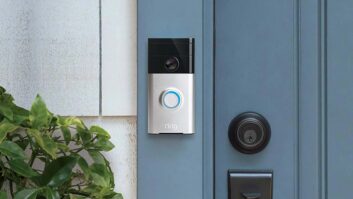SAN RAMON, CALIF. — The Nest-led Thread Group, which is developing a wireless mesh-network home-automation technology, plans to release its spec in June and launch a consumer-product certification testing program in June or July.
The developments will set the stage for member companies to ship certified products in the early to middle second half, group president Chris Boross told TWICE.
While developing the standard, the group has expanded its membership to more than 80 companies since its formation in mid-2014. The latest include home-automation supplier Insteon; Somfy, the marketer of motorized blinds, shades and projection screens; and Tyco, the fire protection and security company. Other consumer-products member companies include Yale Security, Samsung Electronics, Nest Labs, Big Ass Fans, Kwikset, Moen, Philips, Whirlpool and smart-vent maker Keen Home.
Though the timelines for certification and shipment seem clear, individual companies’ specific implementation of the Thread standard isn’t. That’s because the 2.4GHz meshnetwork technology, which is built on the existing IEEE 802.15.4 radio standard, ensures interoperability at the network communications level but doesn’t mandate an application layer with command protocols. Suppliers are left to choose their own applications layer, and they could choose proprietary protocols that prevent their products from talking to other-brand Thread-equipped products.
Implementation Options
Boross, who is also Nest’s technical product marketing manager, said members have multiple options, including the use of an open, and potentially licensed, applications layer to communicate commands to otherbrand Thread products. One product could then trigger actions by other-brand products or create scenes with other-brand products. Alternately, companies could incorporate multiple protocols to interoperate with products from multiple brands. The choice of protocols, however, is beyond the Thread Group’s mission, he said.
Another way to deliver interoperability is through a control hub, although the Thread standard doesn’t require one. Thread Group member Insteon, for example, could add the technology and multiple protocols to its control hub to enable different brands of Thread products to converse. Insteon’s hub already incorporates multiple radios and protocols to control products incorporating its wireless standard and other wireless standards.
Some marketers, however, believe Nest might offer up an applications layer of its own to other companies. That would enable a future Thread-compliant version of Nest’s Wi-Fi thermostat to communicate with and control those companies’ Thread-equipped sensors and devices – and take advantage of Thread’s key selling points, such as low-power consumption by battery-operated sensors and door locks (see story at right).
Nest’s smart Wi-Fi thermostat and smoke/CO detector already incorporate a form of Thread and could be upgraded to the full Thread standard.
Thread: The Next ZigBee?
Nonetheless, a Tower of Babel could be in the offing. “There are a lot more companies looking for solid transports and a big brand name (Thread or ZigBee) that do not want to have to interoperate with their competitors than those that want product-level interoperability,” one marketer told TWICE. “This is true for ZigBee Pro as well.”
“A lot more manufacturers have adopted ZigBee Pro with proprietary upper layers than for ZigBee Pro with an interoperable upper layer like HA1.2,” he said.
If that’s how the Thread market plays out, the marketer continued, then “just like Zig- Bee, Thread will be a very confusing brand/ standard for consumers who will think it stands for product-level interoperability.”
There are ways to reduce confusion, however. “If a company tries to build a productlevel interoperable ecosystem on top of Thread, it is most likely that they will have to ‘oversell’ the Thread brand and make it a secondary brand to the ecosystem brand,” the marketer said. Such a manufacturer could adopt such terminology as “Works together, powered by Thread,” he contended.
Even if different-brand Thread products lack product-level interoperability, Thread still offers advantages, marketers said. All Thread products act as repeaters for other Thread products to extend range and reliability in a home. “They can talk, though they might not know what to say,” one marketer said.
Odds of Success
Although Thread standardizes only the radio (physical layer) and the media access control (MAC) layer, it could still be a success, said Tom Kerber, Parks Associates director of home controls and energy research. “Standards such as Wi-Fi have been very successful by defining only the media access control and physical layers.”
If interoperability is the goal, then control hubs are one way to achieve it, he added. “It is common for a hub to include Wi-Fi, Z-Wave, and ZigBee HA” because individual products such as door locks or sensors “generally do not have multiple radios,” he explained.
Alternately, manufacturers could take a modular approach with individual door locks and other products, he pointed out. A modular approach would let suppliers swap out a communications card in a product to incorporate different wireless standards. “USNAP is one standard that enables this approach,” he pointed out. Door-lock manufacturers use this architecture to enable their products to work with Z-Wave, ZigBee or proprietary wireless home-automation technologies.
Nest Upside
If the goal is to create a network of Thread devices that interoperate with Nest’s thermostats and sensors, it would help Nest move farther toward what Kerber called “a distributed- intelligence architecture.” This architecture enables a device to communicate with other devices “to gather the information it needs so it can operate more efficiently or provide more value to the consumer,” he explained.
Nest’s Wi-Fi thermostat already works with other-brand products to gather information about occupancy, such as Chamberlain Wi-Fi garage-door openers, to understand when a vehicle enters or leaves the garage, he said. Nest “also connects to vehicles to understand the location of those vehicles relative to the home and to a security panel to understand the status of motion sensors and door sensors located throughout the home,” he continued. “After gathering this data, Nest can make a good estimate of whether or not the home is occupied and automatically set back the temperature to eliminate waste and save money.”
Today, Kerber noted, “most of those integrations are done via APIs in the cloud, but Thread may enable a peer-to-peer communication scheme such as AllJoyn to provide a mechanism to do the same type of data collection locally.”
Whether Thread moves Nest closer toward implementing a distributed-intelligence architecture might not be known for a few more months, nor will various vendors’ approach to Thread.













